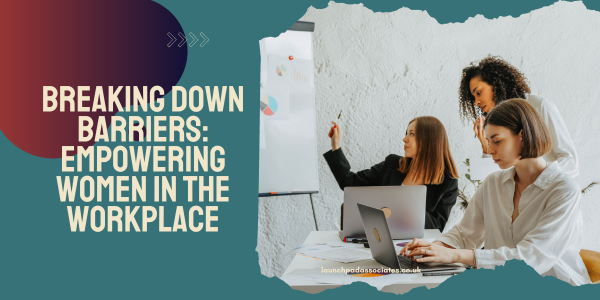Gender Equality in the Workplace: Breaking Down Barriers
Introduction
Gender equality in the workplace is essential for creating an inclusive and productive environment. Despite progress, many barriers still prevent achieving true equality. Addressing these barriers involves examining systemic issues, implementing effective strategies, and fostering a culture of inclusion. This article explores key barriers to gender equality in the workplace and offers strategies to break them down.

Understanding Workplace Gender Inequality
Persistent Challenges
Workplace gender inequality manifests in various ways:
- Pay Gap: Women and non-binary individuals often earn less than their male counterparts for similar work.
- Promotion Disparities: Gender biases can limit advancement opportunities for women and other underrepresented groups.
- Workplace Culture: Stereotypes and biases contribute to an unequal work environment.
Impact on Employees and Organizations
Gender inequality affects both individuals and organizations:
- Employee Morale: Inequality can lead to lower morale, decreased job satisfaction, and higher turnover rates.
- Organizational Performance: Companies with diverse and inclusive workplaces often experience better performance and innovation.
Key Barriers to Gender Equality in the Workplace
Gender Stereotypes and Bias
Influence of Stereotypes
Stereotypes and biases impact hiring, promotions, and daily interactions:
- Unconscious Bias: Employers may unconsciously favor candidates of a particular gender for certain roles.
- Cultural Norms: Traditional gender norms can influence expectations and treatment in the workplace.
Case Example: Leadership Roles
Women and non-binary individuals are often underrepresented in leadership roles due to biases that suggest leadership qualities are more aligned with traditional male traits.
Inequitable Policies and Practices
Access to Opportunities
Inequitable policies and practices limit access to opportunities:
- Promotion Policies: Lack of transparency in promotion criteria can disadvantage women and non-binary individuals.
- Flexible Work Arrangements: Limited availability of flexible work options may disproportionately affect those with caregiving responsibilities.
Case Example: Parental Leave Policies
Inadequate parental leave policies can impact career progression, particularly for women, who often take on a larger share of caregiving responsibilities.
Lack of Support and Mentorship
Importance of Support
Support and mentorship are crucial for career advancement:
- Mentorship Programs: Lack of mentorship and sponsorship opportunities can limit career growth for women and non-binary individuals.
- Networking Opportunities: Exclusion from informal networks can affect professional development and access to advancement opportunities.
Case Example: Networking Gaps
Women and non-binary individuals may face challenges accessing the same networking opportunities as their male counterparts, affecting career progression.
Strategies for Breaking Down Barriers
Implementing Inclusive Policies
Developing Fair Policies
Creating and implementing inclusive policies is essential for promoting gender equality:
- Transparent Promotion Criteria: Establish clear and transparent criteria for promotions and career advancement.
- Flexible Work Options: Offer flexible work arrangements to support diverse needs and responsibilities.
Case Example: Gender-Neutral Policies
Organizations that implement gender-neutral policies, such as equal parental leave and flexible working hours, create a more inclusive and supportive environment.
Addressing Unconscious Bias
Bias Training
Training programs can help address unconscious biases:
- Workshops and Seminars: Provide regular workshops and seminars on unconscious bias and its impact on decision-making.
- Inclusive Hiring Practices: Adopt inclusive hiring practices that reduce the influence of bias in recruitment and promotion processes.
Case Example: Bias Training Programs
Companies that implement bias training programs see improvements in hiring practices and workplace culture, leading to greater gender equality.
Promoting Mentorship and Networking
Building Support Networks
Creating opportunities for mentorship and networking supports career development:
- Mentorship Programs: Establish formal mentorship programs to connect employees with experienced mentors.
- Networking Events: Organize networking events that foster connections and professional development for all employees.
Case Example: Mentorship Initiatives
Organizations with robust mentorship and networking programs help to level the playing field, providing equal opportunities for career growth.
Fostering an Inclusive Culture
Building a Supportive Environment
A supportive and inclusive workplace culture is vital for gender equality:
- Inclusive Leadership: Promote inclusive leadership practices that value and support diverse perspectives.
- Employee Resource Groups: Create and support employee resource groups that focus on gender equality and diversity.
Case Example: Inclusive Leadership Training
Training leaders to adopt inclusive practices helps build a workplace culture that values and supports gender diversity.
Measuring Progress and Ensuring Accountability
Tracking Metrics
Measuring progress in gender equality involves tracking key metrics:
- Gender Disaggregation: Collect and analyze data on gender representation, pay equity, and promotion rates.
- Employee Feedback: Use surveys and feedback mechanisms to assess employee experiences and identify areas for improvement.
Continuous Improvement
Continuous improvement is crucial for achieving lasting change:
- Regular Assessments: Conduct regular assessments of policies and practices to ensure they are effective and equitable.
- Adaptation and Refinement: Adapt strategies based on data and feedback to address emerging issues and maintain progress.
Conclusion
Breaking down barriers to gender equality in the workplace requires a comprehensive approach that addresses stereotypes, inequitable policies, and lack of support. By implementing inclusive policies, addressing unconscious bias, promoting mentorship, and fostering an inclusive culture, organizations can create a more equitable environment. Measuring progress and ensuring accountability through tracking metrics and continuous improvement are essential for achieving and sustaining gender equality in the workplace. Investing in these strategies not only benefits individuals but also enhances organizational performance and innovation.



